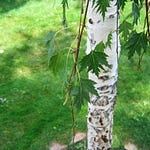A walk on a June afternoon leads to meeting a dragonfly and making a friend. How dragonflies see, how they hunt—more efficiently than lions!—and how they can recognize humans.
Transcript
We were living on Lopez Island, off the Washington coast, in a cabin under fir trees, and every day we took a walk up our dirt road. The walk was a habit our Bodhi had instilled in us for the ten years he was with us, and he was such a persuasive teacher that even now, after he was gone, we continued following his lead. There was always something new to see along the road—a different filter of light through the fir trees, a new wildflower blooming. Or maybe a neighbor to say hello to.
On this June afternoon the sun was high in the sky. I headed past the sheep pasture on the left, past the community meadow on the right, its grass waving tall, up the road to where the waist-high ferns fanned out along the ditch. Suddenly—a glint of silver over the ferns.
It was a dragonfly, a large one, but what kind? I had no idea. I’d observed so many creatures over the years, but rarely dragonflies. Today was the day to learn more. I stopped and raised my binoculars.

Oh, my—those spots on its wings! Patches of ice blue, a color I didn’t know existed on dragonflies. Later I would learn the field guides call those patches “white.” Trust me, they’re not white. They’re blue, like the palest blue chiffon imaginable. Like winter sky reflected on an icy pond.
Each ice-blue patch sat next to a patch of black, four of each color arranged across the forewings and four of each on the hindwings. And all eight patches set on those—oh, my!—magical see-through cellophane wings partitioned with veins. I was staring at a crinkling sea of sunshine waves flowing end to end across three inches of wings. Marvelous.
I stared and stared, trying to absorb every detail. I could do this because the dragonfly, who I would later learn was an eight-spotted skimmer, a male, was sitting perfectly still for minutes at a time. Once in a while he would suddenly rise up, hover for a moment, fly off twenty or thirty feet away, then glide quickly back to the same spot on the same fern. He could hover and dart, I would learn, because each of his wings moved independently of the others, each wing attached by its own muscles to his slender body.
Those wings alone could fill a lifetime of looking. But my eyes finally turned toward his head. Glassy black, like polished onyx. In the small gap at the back of his head, where the head joins the thorax, a tiny bump, off center. Was that a tick? I never did find out. Where were his eyes? In that shiny black expanse of a head, it was hard to tell.
A little research later told me that the glassy black head was in fact his eyes—two enormous compound eyes, each with thirty thousand individual facets, each facet carrying its image straight to the dragonfly brain, where these 60,000 images were being put together, split second by split second, into a whole picture. I learned that dragonflies can see forward and backward and all around—a full 360 degrees—and they can see all the colors we humans can see plus ultraviolet. Their world must be dazzling.
The dragonfly’s head would turn—now a little in this direction, now that—and then he would lift off again, and after a few seconds return to his fern. I found out that dragonflies hunt not by tracking their prey—following it patiently and catching up with it—but by intercepting it. This means that dragonflies are calculating, in that fantastic dragonfly brain, where, on the basis of speed and direction, the prey is going to be a few moments in the future, and they zero in on that future spot like tiny fighter jets. Their amazing eyes and brains give them the title of most efficient hunters in the wild, catching their prey 95 percent of their tries. By contrast, lions score only 50 percent.
So there we were on a summer afternoon, me gazing through binoculars, he a shimmering glory in the sunlight. His wings, forever sparkling. His long slender abdomen, in segments of blue, also shining. His feet, black and strong, grasping the fern. On the leading edges of his wings, the tiniest line of black against those ice-blue spots.
I felt the warmth of wonder spread throughout me. Appreciation bubbled up for him—a being so different from me, so knowledgeable about his world, so keen and intelligent in dragonfly ways. Just by watching and appreciating, I was getting to know him. And I loved him. I wondered if he could feel it. Most beings can. I wondered if he saw me. Once I learned about dragonfly eyes, I realized how ignorant my question was—and arrogant at the same time.
After gazing and appreciating him for some time, I finally tore myself away and continued on my walk.
But then this happened: The next day I walked down the road at the same time of afternoon. Just as I arrived at the spot where I’d met the dragonfly, a sparkling set of wings rose up before me. There he was, crisscrossing the road, zooming up, down, and around. Blocking my walk until I paused to say hello. I stopped and admired him again. I saw him; I felt seen.
If you pause this way with a dragonfly, it is possible to make a friend. I have heard other people say this too. Dragonflies take note of humans, at least those who stop to say hello. And why not? With those keen eyes, and that brain compiling tens of thousands of images every nanosecond, why wouldn’t they recognize individual humans?
I recommend saying hello to a dragonfly this way. Making a dragonfly friend is worth it. It is so worth it.
For digging deeper
Richard Louv tells the story here of artist Susan McDonnell and how a dragonfly changed the very way she painted. On the Children & Nature Network site.
For a stained-glass artist’s close-up study of a dragonfly wing, see Arthur Melville Pearson’s piece, “Lux, Lumen, Illumination Redux,” on the City Creatures blog at the Center for Humans and Nature site.
If you don’t know either of these organizations, have fun browsing their wonderful websites, where you can surf for hours on nature-themed reflections, research, and first-person stories.
Update Sept. 2020
Astronomer Pieter Dokkum has a passion for photographing dragonflies up close, and you can enjoy some astounding photos from his new book, Dragonflies: Magnificent Creatures of Water, Air, and Land, on this page at My Modern Met.













Share this post